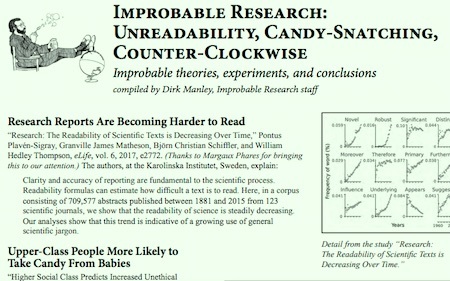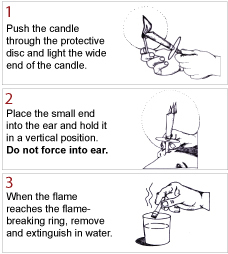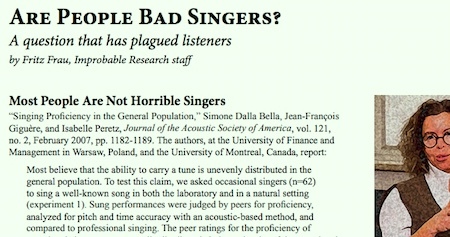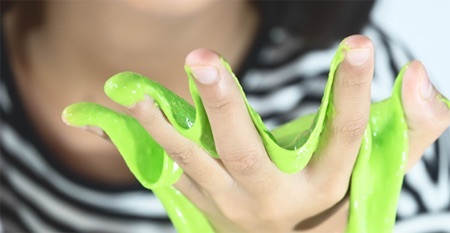Marc Abrahams's Blog, page 187
May 14, 2018
Helium-voice singer dangers (report)
 Are you a singer? Are you endeavouring to reach ever higher notes? With the assistance of helium inhalations? Maybe think again.
Are you a singer? Are you endeavouring to reach ever higher notes? With the assistance of helium inhalations? Maybe think again.
“A 23-year-old singer inhaled helium from a high-pressure tank to produce a change in his voice. The last of the eight inspiratory efforts was accidentally done without pressure reduction. As described by his colleagues, he collapsed and became unconscious within seconds. Spontaneous breathing was present. He was urgently transported to the emergency department.”
Fortunately, the patient recovered his full health after three weeks or so. See: Cerebral and coronary gas embolism from the inhalation of pressurized helium in Critical Care Medicine: May 2002 – Volume 30 – Issue 5 – p 1156-1157.
Note: The photo shows Sir William Ramsay, the discoverer of terrestrial helium.

May 13, 2018
How to Identify a Narcissist: Check the Eyebrows [research study]
Even people who are not narcissists may be fascinated by narcissists. This newly published study directs everyone’s attention to the eyebrows:
“Eyebrows Cue Grandiose Narcissism,” Miranda Giacomin and Nicholas O. Rule, Journal of Personality, epub 2018. (Thanks to Minna Lyons for bringing this to our attention.) The authors, at the University of Toronto, explain:
Though initially charming and inviting, narcissists often engage in negative interpersonal behaviors…. Here, we investigated which facial features underlie perceptions of grandiose narcissism and how they convey that information.
Method and Results: In Study 1, we explored the face’s features using a variety of manipulations, ultimately finding that accurate judgments of grandiose narcissism particularly depend on a person’s eyebrows. In Studies 2A-2C, we identified eyebrow distinctiveness (e.g., thickness, density) as the primary characteristic supporting these judgments. Finally, we confirmed the eyebrows’ importance in Studies 3A and 3B by measuring how much perceptions of narcissism changed when swapping narcissists’ and non-narcissists’ eyebrows between faces.
Conclusions: Together, these data show that distinctive eyebrows reveal narcissists’ personality to others, providing a basic understanding of the mechanism through which people can identify narcissistic personality traits with potential application to daily life.”

May 11, 2018
Unreadability, candy-snatching, and other improbable research
“Improbable Research: Unreadability, Candy-Snatching, Counter-Clockwise“, in the special Music issue of the Annals of Improbable Research, gathers research about unreadability, candy-snatching, and maybe why some kinds of races are mostly run counter-clockwise. Read the article free (PDF). Then, if you dare, purchase the issue, or subscribe to the magazine.

May 10, 2018
Ear candling action overdue in New Zealand?
Some of those who suffer the inconveniences of excessive ear-wax turn to a radical remedy – a fire-based process called ‘ear-candling’ [see diag.]
“Ear candles have been used for centuries and is [sic] considered a painless, inexpensive and non-invasive way to potentially remove ear wax that is easy to use in the privacy of your home.”
Not everyone though, is convinced of the safety of the treatment :
“In 2010, the FDA and Health Canada acted against manufacturers of ear candles. These actions have included import alerts, seizures, injunctions and warning letters. The authorities warn consumers of the potential risks:
● burns to the face, ear canal, eardrum and middle ear
● injury to the ear from dripping wax
● ears plugged by candle wax
● bleeding
● puncture of the eardrum
● delay in seeking needed medical care for underlying conditions such as sinus and ear infections, hearing loss, cancer and temporomandibular joint (TMJ) disorders. (TMJ disorders often cause headache and painful sensations in the area of the ear, jaw and face).”
See: Ear candling action overdue in The New Zealand Medical Journal, July 2017, Volume 130 Number 1458
Note : The paper cites ‘Happy Ears’ candles, the instructions for which are shown above.
BONUS (fire related) : Bob Newhart imagines a phone conversation between Sir Walter Raleigh and the head of the West Indies Company in England.

May 9, 2018
Two rubber band technique for finger ring removal
Researchers have attempted many solutions to remove rings from the fingers they are stuck on, including the use of dental equipment, a finger part of a surgical glove cut off cylindrically, ribbon gauze and a paper clip, and the classic caterpillar technique.
Australian researchers from University of Queensland and Gold Coast University Hospital report on a newer method for finger ring removal, the two rubber band technique.
“A two rubber band technique was used in this study of 69 difficult to remove rings… The endpoint for the study was success or failure to remove the ring.”
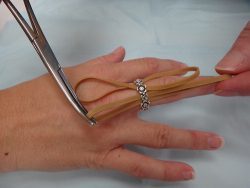
Figure 2
The two rubber band technique uses two rubber bands to slide underneath of the ring. Liquid soap and small artery forceps aided in getting the rubber bands into the appropriate position.
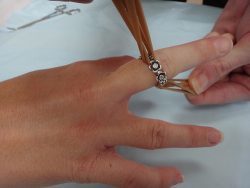
Figure 4
Once through, the rubber bands are rotated back and forth “…through an arc of 180° in alternating directions (similar to turning a wheel on a car) (Fig 4).”
Sixty two rings were successfully removed, with minimal discomfort in all cases. Five rings were unable to be removed, and two rings did not undergo the technique after concerns that the owner would not be able to get the rings back on.
“Rubber bands were chosen over string as they grip the ring slightly, facilitating oscillation around the digit. Furthermore, the technique does not harm the ring and the ring cannot fall to the floor after removal.”
This claim in the report is clearly visible in Figure 5, where the ring is suspended by the two rubber bands, unable to fall to the floor.
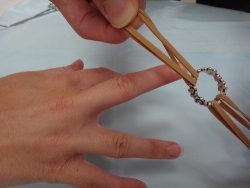
Figure 5
Kingston, D., Bopf, D., Dhanjee, U. and McLean, A. (2016). Evaluation of a two rubber band technique for finger ring removal. The Annals of The Royal College of Surgeons of England, 98(5), pp.300-302.

May 8, 2018
The Measured Jumps of a Regal Jumping Spider
How much jumping would a jumping spider jump if a bunch of scientists made her keep jumping? One answer to that, involving one spider—a regal jumping spider—appears in this study, and in an accompanying video:
“Energy and Time Optimal Trajectories in Exploratory Jumps of the Spider Phidippus regius,” Mostafa R.A. Nabawy, Girupakaran Sivalingam, Russell J. Garwood, William J. Crowther, and William I. Sellers, Scientific Reports, vol. 8, no. 7142, 2018. The authors, at the University of Manchester, report:
“One spider was inclined to jump within the experimental apparatus; the other three were unwilling to jump. All jumps were collected within a week. Body mass was monitored on daily basis and confirmed as approximately constant. We did not use prey as a bait item as this would mean one jump per week based on the observed diet of the spider. Instead, the spider was manually transported between the take-off and landing platforms until it became familiar with the challenge.”
The university wrote a background essay about the the spider’s adventure.
(Thanks to Marc Andelman for bringing this to our attention.)

Are People Bad Singers?
“Are People Bad Singers?”, in the special Music issue of the Annals of Improbable Research, gathers research about that high-pitched question. Read the article free (PDF). Then, if you dare, purchase the issue, or subscribe to the magazine.

May 7, 2018
Pasta that’s boiled longer is softer (new study)
If you like pasta with tomato sauce (e.g. Neapolitan style) you may have asked yourself, ‘Which factors affect the suitability of boiled pasta with tomato sauce for eating?’ If so, a new paper from the Japanese Society of Food Science and Technology could be of interest.
“Physical properties of the pasta boiled for the shortest time changed greatly when sauce was added. The texture of the pasta boiled for the longest time was soft, because the core lacked a non-gelatinized region. In a force–strain curve, the change in the force after the breaking point of the pasta boiled for the shortest time was the largest after sauce addition.“
See: ‘Factors Affecting the Suitability of Boiled Pasta with Tomato Sauce for Eating’ in Food Science and Technology Research, Volume 24 (2018) Issue 1.
Note: In Japan, ‘Neapolitan’ pasta is known as ‘Naporitan’.

May 5, 2018
Visual evaluation of sliced Italian salami [research study]
Italian researchers Annalisa Romano, Paolo Masi, and Silvana Cavella take a close look at slices of salami in their paper, “Visual evaluation of sliced Italian salami by image analysis.”

Figure 1. Image of sliced salami batches a-p
Rather than using chemical analysis to determine the fat content in the salami, Romano’s team utilized computers to visually inspect the fat content. The computers were trained to tease out several parameters, such as the number of fat particles, the fat particle area, and the intriguing ‘fat particle roundness’ parameter.
The researchers also assumed that the thickness of each slice was identical, making the approximation that “… the salami slice was representative of a salami of infinite length.”
Romano’s team concludes:
“The results confirmed that the image analysis protocol developed could extract the fat content automatically with good degree of accuracy (R2=0.75)… Further testing on larger type of meat products will be necessary before the presented procedure can be accepted and then used as a common method for measuring lipid in sliced sausage.”
The real meat of the research can be found here: Romano, A., Masi, P. and Cavella, S. (2017). Visual evaluation of sliced Italian salami by image analysis. Food Science & Nutrition, 6(1), pp.153-159.
BONUS: As an inverse of a study on sliced salami, check out an example of a study that has been salami sliced in Scientific Salami Slicing: 33 Papers from 1 study.

May 4, 2018
Government warning about Slime
The French government has issued an official warning about Slime.
The warning comes from ANSES [Agence nationale de sécurité sanitaire de l’alimentation, de l’environnement et du travail]. It bears the headline “Le Slime, une pâte très prisée mais pas sans risque.” Here’s a machine-translation of the first paragraph:
“ANSES and the DGCCRF alert consumers to the risks associated with the manufacture and handling of Slime. Slime, a sticky and elastic kneading paste, is currently popular with children and adolescents. It is commercially available in ready-to-use form or in kits. The Slime can also be made at home, to vary the appearance and texture (color, glitter …). Slime’s manufacturing tutorials are multiplying on the Internet and many recipes are proposed, based on constituents such as paper glue and laundry. Several cases of cutaneous involvement related to the manufacture and handling of “home” Slime have been reported to ANSES, by the poison control centers, the Revidal-Gerda dermato-allergology surveillance network and the AllergOS network. In this context, ANSES and the DGCCRF draw attention to the risks associated with contact with toxic products, diverted from their use, during the manufacture and then the handling of “home” Slime. Regarding the boxes sold in toy stores, they also call on users to respect the precautions for use kits.”
(Thanks to Marc Gozlan for bringing this to our attention.)

Marc Abrahams's Blog
- Marc Abrahams's profile
- 14 followers


